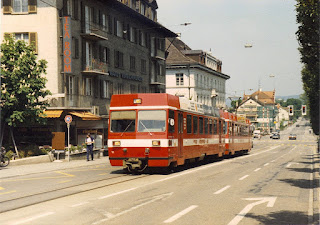Back in August 1988 I stopped off at Bicester Town station to take a couple of photographs.
Back then station reopenings were rare, line reopenings even rarer, so this was something of a novelty. And now the line is being
developed further and will eventually form part of an east-west link between
Oxford and Cambridge, a line that was stupidly closed back in 1968. Back then planners thought that we'd all just travel from our backwards little towns to London and never go anywhere else. How wrong they were!
History

Bicester London Road with two platforms in 1961
The
Buckinghamshire Railway, which already had a route between
Bletchley and
Banbury, had powers to build a line to
Oxford. The first part of this line, from a junction to the west of
Winslow (at a point which became known as
Verney Junction) to
Islip, opened on 1 October 1850, and this included a station at Bicester.
[1][2] Originally named "Bicester", the station was renamed "Bicester London Road" in March 1954, although the nameboards were not altered until 20 September 1954.
The station was closed, along with the rest of the Oxford – Bletchley section of the
Varsity Line, on 1 January 1968. However, the station was used by several excursion trains through the 1970s and 1980s.
Since 1987 the frequency of trains has varied and passenger numbers have fluctuated accordingly. In the four years 2007–11 more frequent trains increased the total number of passengers using Bicester Town by 258%.
The station closed on 15 February 2014 (the last trains having run late on 14 February in order to allow upgrade of the line between Oxford and Bicester. The reopening, first planned for May 2015, will be on 26 October 2015.
On 12 March 2015 Chiltern Railways announced that it will rename the station
Bicester Village after the nearby designer retail outlet.
Facilities

Bicester Town station in 1992
Until it closed in 2012 the station had one platform, a covered waiting area, seats, a clock, help point and public address. There was a number of cycle stands but no ticket facilities. Passengers could buy these on the train instead.
There was another track in front of the platform, beside the passenger and freight running line. This was the long reversing siding for the
Bicester Military Railway, serving the local
MOD depot.
[14]
In August 2008
Chiltern Railways announced a proposal to build a
1⁄4 mile (400 m) link between the Oxford to Bicester Line and the
Chiltern Main Line to carry a new service between Oxford and London via
High Wycombe. The single line between Bicester Town and Oxford will be doubled and a new station is being built at
Oxford Parkway. Approval was granted in October 2012.
The Department for Transport has approved the Western Section of the
East West Rail Link to link Oxford and Bicester Town with Milton Keynes and Bedford, as part of CP5. It was intended that trains to Bedford should start running by 2017, but on 31 March 2014 Network Rail announced that this had been put back to 2019.
The station will have two car parks. Between them they will provide 230 standard spaces, plus 18 spaces for passengers with reduced mobility. The station will also have parking for 60 pedal cycles and 18 motorcycles.
Services
From December 2008 the service on Mondays to Saturdays was improved with an evening service and a doubling of the service on Saturdays. The service was increased to 11 trains (12 on Fridays) on weekdays and 13 on Saturdays. From May 2009, further improvements saw extra trains in the daytime on Mondays to Fridays and a new all-year round Sunday service, with trains every 90 minutes.
On 22 May 2011
Chiltern Railways took over all passenger operations from this station ahead of the new service between
London Marylebone and Oxford that was due to start in 2013. It was later amended to 2015.







































